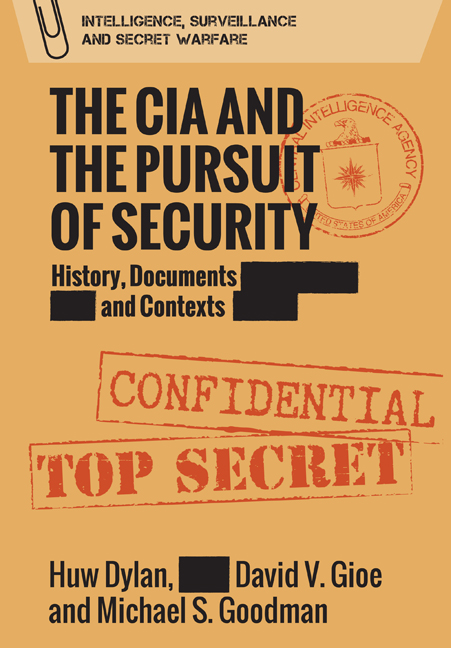Book contents
- Frontmatter
- Contents
- List of Documents
- Foreword
- Acknowledgements
- Introduction
- 1 Intelligence for an American Century: Creating the CIA
- 2 The Development of CIA Covert Action
- 3 A ‘Gangster Act’: The Berlin Tunnel
- 4 The CIA and the USSR: The Challenge of Understanding the Soviet Threat
- 5 Anglo-American Intelligence Liaison and the Outbreak of the Korean War
- 6 The CIA and the Bomber and Missile Gap
- 7 The CIA and Cuba: The Bay of Pigs and the Cuban Missile Crisis
- 8 The CIA in Vietnam
- 9 The CIA and Arms Control
- 10 The CIA’s Counter-Intelligence Conundrum: The Case of Yuri Nosenko
- 11 1975: The Year of the ‘Intelligence Wars’
- 12 Watching Khomeini
- 13 The CIA and the Soviet Invasion of Afghanistan
- 14 Martial Law in Poland
- 15 Able Archer and the NATO War Scare
- 16 The Soviet Leadership and Kremlinology in the 1980s
- 17 The CIA and the (First) Persian Gulf War
- 18 A Mole in Their Midst: The CIA and Aldrich Ames
- 19 ‘The System was Blinking Red’: The Peace Dividend and the Road to 9/11
- 20 Reckoning and Redemption: The 9/11 Commission, the Director of National Intelligence and the CIA at War
- 21 The ‘Slam Dunk’: The CIA and the Invasion of Iraq
- 22 The Terrorist Hunters Become Political Quarry: The CIA and Rendition, Detention and Interrogation
- 23 Innovation at the CIA: From Sputnik to Silicon Valley and Venona to Vault 7
- 24 Entering the Electoral Fray: The CIA and Russian Meddling in the 2016 Election
- 25 Flying Blind? The CIA and the Trump Administration
- Bibliography
- Index
9 - The CIA and Arms Control
Published online by Cambridge University Press: 24 September 2020
- Frontmatter
- Contents
- List of Documents
- Foreword
- Acknowledgements
- Introduction
- 1 Intelligence for an American Century: Creating the CIA
- 2 The Development of CIA Covert Action
- 3 A ‘Gangster Act’: The Berlin Tunnel
- 4 The CIA and the USSR: The Challenge of Understanding the Soviet Threat
- 5 Anglo-American Intelligence Liaison and the Outbreak of the Korean War
- 6 The CIA and the Bomber and Missile Gap
- 7 The CIA and Cuba: The Bay of Pigs and the Cuban Missile Crisis
- 8 The CIA in Vietnam
- 9 The CIA and Arms Control
- 10 The CIA’s Counter-Intelligence Conundrum: The Case of Yuri Nosenko
- 11 1975: The Year of the ‘Intelligence Wars’
- 12 Watching Khomeini
- 13 The CIA and the Soviet Invasion of Afghanistan
- 14 Martial Law in Poland
- 15 Able Archer and the NATO War Scare
- 16 The Soviet Leadership and Kremlinology in the 1980s
- 17 The CIA and the (First) Persian Gulf War
- 18 A Mole in Their Midst: The CIA and Aldrich Ames
- 19 ‘The System was Blinking Red’: The Peace Dividend and the Road to 9/11
- 20 Reckoning and Redemption: The 9/11 Commission, the Director of National Intelligence and the CIA at War
- 21 The ‘Slam Dunk’: The CIA and the Invasion of Iraq
- 22 The Terrorist Hunters Become Political Quarry: The CIA and Rendition, Detention and Interrogation
- 23 Innovation at the CIA: From Sputnik to Silicon Valley and Venona to Vault 7
- 24 Entering the Electoral Fray: The CIA and Russian Meddling in the 2016 Election
- 25 Flying Blind? The CIA and the Trump Administration
- Bibliography
- Index
Summary
Securing insight into foreign scientific and technical developments has always been a significant priority for spies – just as important as protecting a home nation's own engineering developments. Intelligence, weapons proliferation and counter-proliferation have historically been closely related. Intelligence was, in several senses, crucial to the development of the Cold War superpower nuclear arms race. The relentless intelligence effort of the USSR's intelligence services yielded the secrets of the Manhattan Project, easing Stalin's development of his first atomic bomb. Thereafter, all sides expended tremendous effort to understand the adversary's nuclear infrastructure and gauge their capabilities and intentions. But as the twentieth century progressed and the superpowers shifted, incrementally and stutteringly, from arms races to a degree of arms control, the intelligence machinery found another role beyond espionage and counter-intelligence: namely, monitoring and verification.
For at least the first twenty years of the Cold War, the US enjoyed a marked strategic advantage over the USSR. Despite certain key instances where the Soviets had stolen a march in developing strategic systems, such as developing versions of intercontinental bombers in the 1950s, or testing their first ICBM before the US in August 1957, these gains were soon offset. The US, with its NATO allies, compensated for any lag in long-range strategic capability by deploying shorter-range assets in Europe, closer to the USSR; and they soon developed their own ICBMs and intercontinental bombers and proceeded to build more of them more quickly than the USSR. Despite fears of a strategic imbalance in favour of the Soviets in the 1950s, most notably manifested in the bomber and missile ‘gap’ controversies as discussed in Chapter 6, by the 1960s the US retained this lead. US intelligence could, essentially, prove this beyond reasonable doubt owing to the rapid development of overhead reconnaissance technology: first the U-2 high-altitude aircraft from 1956, and then the CORONA reconnaissance satellite programme after 1961. This intelligence was supplemented by human sources, the most significant being GRU Colonel Oleg Penkovsky (introduced in Chapter 7), who was recruited by SIS and run in partnership with the CIA. Penkovsky provided detailed information on the Soviet strategic rocket programme, before being identified and executed.
- Type
- Chapter
- Information
- The CIA and the Pursuit of SecurityHistory, Documents and Contexts, pp. 156 - 170Publisher: Edinburgh University PressPrint publication year: 2020



